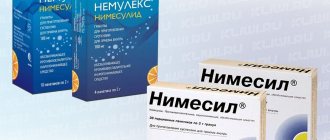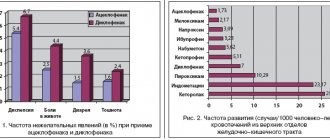Fluifort is a pharmaceutical product for oral administration. Available in several dosage forms. It belongs to the group of mucolytics, and therefore has a pronounced expectorant and mucus-thinning effect. Intended for the treatment of diseases of the bronchopulmonary system. Widely prescribed for adults and children.
Compound
1 packet of granules contains 2.7 grams of carbocisteine ( lysine salt ) and additional substances: cedar flavor, polyvinylpyrrolidone , mannitol , citric acid, orange juice powder and aspartame .
100 ml of syrup liquid contains 9 grams of carbocisteine and additional components: cherry flavor, sucrose, purified water, methyl parahydroxybenzoate, caramel.
Composition and release form
The drug is presented in the form of granulated powder and syrup.
The granules have a pleasant citrus fruit aroma, are small in size and white in color. Packaged in sachets of 5 mg and a total cardboard package of 10 pieces.
The syrup has a liquid texture and a cherry smell. Sold in a glass bottle of 100 ml. The set includes a special measuring cup.
The active component is carbocisteine. Its content in granules is 2.7 g, in syrup 9 g.
Additional substances: flavorings, citric acid, mannitol, aspartame and orange juice in granular form. Also sucrose, pure water, cherry flavoring and caramel in syrup.
pharmachologic effect
The medication has expectorant and mucolytic effects. The principle of action is based on the activation by carbocysteine of the enzyme sialic transferase, which is located in the mucous wall of the bronchi. The active substance of the drug normalizes the ratio of acidic and neutral sialomucins in sputum, improves elasticity and normalizes sputum viscosity.
During treatment, normalization of the ciliated epithelium is recorded, the structure of the mucous membranes is restored, and regeneration . The active component increases immunity (specific, nonspecific), enhances mucociliary clearance .
Indications for use
Fluifort is prescribed for diseases of the bronchopulmonary system (acute and chronic forms), accompanied by the formation of viscous secretion and difficult to separate sputum:
- bronchial asthma;
- bronchitis;
- bronchiectasis;
- tracheitis;
- tracheobronchitis.
The medication can be prescribed for pathology of the ENT organs , accompanied by the production of viscous mucus:
- otitis media;
- sinusitis;
- adenoiditis;
- rhinitis.
Cough powder can be prescribed before diagnostic procedures: bronchoscopy , bronchography .
Indications
The drug is prescribed in the complex treatment of diseases of the respiratory system:
- for bronchitis;
- tracheitis;
- bronchiectasis pathology;
- bronchial asthma;
- acute and chronic inflammation with the formation of viscous secretion;
- diseases of the paranasal sinuses: rhinitis, sinusitis, adenoiditis.
In some cases, Fluifort is used in the treatment of inflammation of the middle ear, in the preparatory period before bronchoscopy, bronchography and other diagnostic procedures.
Contraindications
The drug is not prescribed for individual hypersensitivity to carbocysteine .
Cough syrup contains sucrose and is contraindicated in patients with diabetes mellitus .
The powder is not used in the treatment of patients suffering from phenylketonuria .
For ulcerative pathology of the digestive system, the medication is not prescribed.
In pediatric practice, syrup can only be used in the treatment of children from 1 year of age (granules - from 16 years of age).
Application and dosage
Take Fluifort orally 1 time per day after meals:
- syrup is dosed using a spoon or glass, consumed undiluted;
- granules are dissolved in warm water: 1 sachet per 1 glass.
The recommended daily dose of the drug for adults is 2.5 g. When a therapeutic effect occurs (improved sputum discharge), the amount is reduced to 1.5 g per day. For children, medicine is prescribed individually, depending on age and weight. Patients from 1 to 16 years of age are prescribed Fluifort in the form of syrup.
Until the end of treatment, it is necessary to observe an increased drinking regime, since water helps to dilute and increase the volume of mucous secretion in the bronchi and lungs.
The glass must be washed after use. The prepared suspension cannot be left for future use until the next dose.
The duration of treatment with Fluifort is from 4 days. It is not recommended to take it for more than a week without medical supervision. For chronic health problems, the period of therapy can last up to six months.
Side effects
Allergic responses:
- skin rashes;
- skin hyperemia;
- hives.
Nervous system:
- dizziness;
- fast fatiguability;
- migraine.
Digestive tract:
- development of gastritis (rare);
- increased gas formation;
- diarrhea syndrome;
- epigastric pain;
- nausea.
The above-described adverse reactions are transient and self-limited after discontinuation of the medication.
Side effects
As a result of a course of therapy with a mucolytic drug, the following side effects may occur:
- Dizziness and intense headaches.
- Malaise, fatigue.
- Allergic reactions - itching, hyperemia and skin rashes. Rarely - urticaria.
- Dyspeptic disorders - abnormal stool, heaviness in the abdomen, flatulence, pain in the epigastric region, nausea. Rarely - vomiting and symptoms of gastritis.
If side effects develop, symptomatic treatment is prescribed. Often, the above symptoms disappear on their own after stopping the medication.
Instructions for use of Fluifort (Method and dosage)
How to take Fluifort syrup?
Instructions: the drug is dosed using a measuring cup or a special spoon. The syrup can be washed down with tea or water, but the manufacturer recommends taking the medication in undiluted form. After taking the drug, the measuring device must be washed under running water. The use of Fluifort does not depend on food intake. During the entire course of treatment, it is recommended to consume an increased amount of water.
How to take Fluifort powder?
Before each dose, it is necessary to prepare a fresh solution; it is unacceptable to use the solution after long-term storage. The contents of 1 packet are diluted in 1 glass of water, taken once a day. The duration of treatment is from 4 days to six months.
Buy Fluifort granules for the preparation of suspension 2.7 g 5 g No. 10 in pharmacies
Dosage form:
granules for the preparation of suspension for oral administration 2.7 g / 5 g
Compound:
One sachet contains:
Active ingredient: carbocisteine lysine salt monohydrate 2.7 g
Auxiliary components – citric acid 0.080 g, mannitol 0.9185 g, povidone 0.1 g, natural cedar flavor 0.04 g, natural orange flavor 0.04 g, orange juice powder 0.2960 g, aspartame 0.03 g, malto-dextrin 0.7955 g
Description
Granules from white to light yellow.
The reconstituted solution is matte light yellow in color with a citrus scent.
Pharmacotherapeutic group: mucolytic agent.
Pharmacological properties
The mucolytic and expectorant effect is due to the activation of sialic transferase, an enzyme of goblet cells of the bronchial mucosa. Normalizes the quantitative ratio of acidic and neutral sialomucins in bronchial secretions, restores the viscosity and elasticity of mucus. Promotes the regeneration of the mucous membrane, normalizes its structure, and activates the activity of the ciliated epithelium. Restores the secretion of immunologically active IgA (specific protection) and the amount of sulfhydryl groups of mucus components (nonspecific protection), improves mucociliary clearance.
Pharmacokinetics
Rapidly and completely absorbed after oral administration. The maximum concentration in the blood and secretions is achieved within the first hour after taking the drug. The therapeutic concentration remains in the blood for 8 hours. T1/2 -1.8 hours (at a dosage of 2 g/day).
It is excreted mainly in the urine, approximately 30-60% unchanged, the rest in the form of metabolites.
Indications
Acute and chronic bronchopulmonary diseases, accompanied by the formation of viscous and difficult to separate sputum (tracheitis, bronchitis, tracheobronchitis, bronchial asthma, bronchiectasis) and mucus (inflammatory diseases of the middle ear and paranasal sinuses - rhinitis, adenoiditis, otitis media, sinusitis), preparing the patient for bronchoscopy or bronchography.
Contraindications
Hypersensitivity to carbocisteine, peptic ulcer of the duodenum and stomach (in the acute phase). Children under 16 years of age, pregnancy (first trimester), lactation period, phenylketonuria.
Carefully
Pregnancy (II-III trimester), peptic ulcer of the stomach and duodenum (history).
Use during pregnancy and breastfeeding
The use of the drug in the 1st trimester of pregnancy and during breastfeeding is not recommended.
Directions for use and doses
Inside.
Adults: 1 sachet per day.
Dissolve the contents of the sachet in drinking water and mix.
The duration of treatment is determined by the doctor (from 4 days to 6 months).
The indicated dosage is maintained for patients with impaired liver and kidney function, as well as for patients with diabetes.
Side effects
The following side effects are typical for carbocisteine - rarely: gastritis, nausea, diarrhea, dizziness, malaise, skin rash.
Carbocysteine lysine salt - rare: epigastric pain, nausea, diarrhea; skin rash.
All of these disorders are transient in nature and disappear after stopping the drug or after reducing the dosage.
If any side effect occurs, you should consult your doctor.
Overdose
Currently, no cases of overdose with Fluifort have been reported.
Possible symptoms of overdose: stomach pain, nausea, diarrhea.
Treatment: symptomatic. There is no specific antidote.
Interaction
There are currently no known cases of interaction between carbocisteine and drugs commonly used in the treatment of respiratory diseases. There was no interaction between the drug and food, as well as substances used for laboratory research. The effect is weakened by antitussive drugs and M-anticholinergic drugs. Increases the effectiveness of glucocorticosteroids (mutually) and antibacterial therapy for infectious and inflammatory diseases of the upper and lower respiratory tract. Enhances the bronchodilator effect of theophylline.
special instructions
From the first days of taking the drug, due to improved secretion removal, the expectorant effect increases.
Fluifort in the form of a granular mixture for oral administration contains the sweetener aspartame. This substance is contraindicated in patients suffering from phenylketonuria.
The use of Fluifort does not lead to addiction or metabolic dependence.
Treatment can be combined with physiotherapeutic procedures.
Release form
5 g of the drug per sachet. 10 sachets of 2.7 g / 5 g in a cardboard box with instructions for use.
Best before date
3 years. Do not use after the date indicated on the package.
Storage conditions
At a temperature not higher than 25 °C. Keep out of the reach of children!
Conditions for dispensing from pharmacies.
Over the counter.
Interaction
The simultaneous administration of antitussives due to the risk of complications due to impaired sputum excretion.
The effectiveness of carbocysteine is reduced when treated with m-anticholinergic drugs .
A synergistic effect is recorded during treatment with glucocorticosteroids .
For inflammatory diseases of the respiratory system, Fluifort enhances the effect of antibiotics .
The bronchodilator effect of theophylline is enhanced by simultaneous treatment with carbocisteine .
Fluifort analogs (substitutes)
Level 4 ATX code matches:
Mukolik
Abrol
Ambrosan
Bronchorus
ACC 100
ACC 200
ACC Long
ACC
Mukolwan
Lazolvan
Bromhexine 8
Bromhexine 8 Berlin-Chemie
Bromhexine
Bronchobos
Carbocisteine
Erdomed
Pulmozyme
Pectolvan C
Halixol
Ambrobene
Preparations of similar action: ACC , Acetine , Mukobene . Structural analogues of Fluifort have not been developed.
Fluifort price, where to buy
The cost of the powder is 270 rubles (10 sachets). Syrup for children can be bought for 180 rubles. The price of Fluifort depends on the pharmacy chain.
- Online pharmacies in RussiaRussia
ZdravCity
- Fluifort syrup 90mg/ml 120mlDompe SPA
RUR 402 order - Fluifort granules for Prig Susp. for internal approx. 2.7g 5g 10 pcs.Dompe Farmaceutici SPA
472 RUR order



